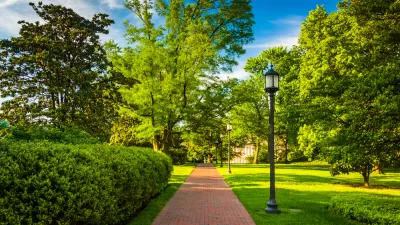Recent analysis shows that Louisville, Ky. suffers from the worst 'heat island' conditions among America's 50 largest cities. The city is also one of the few without a tree ordinance. Coincidence? Sarah Goodyear investigates.

Goodyear looks at the work of Brian Stone of the Urban Climate Lab at Georgia Tech, one of the country's leading researchers on the urban "heat island" effect — "the difference between the temperature of a major metro area and the surrounding countryside."
"Last year, he and his colleagues released an analysis of data [PDF] from the 50 largest cities in America. And it came as something of a surprise that Louisville, Ky. had the unhappy distinction of being on top."
"The average increase in the temperature difference between urban and rural environments in the Louisville area has been 1.67 degrees Fahrenheit every decade between 1961 and 2010," explains Goodyear. "That’s nearly double the rate of the next city on the list, Phoenix, which saw an average change of .96 degrees in the same period."
In addition to "the unfortunate meteorological conditions" of the Ohio River Valley, "another likely contributing factor is the lack of tree cover in Louisville," she notes.
“The tree canopy downtown is one of the sparsest of any city I have seen in the country,” Stone said. "The tree cover in Louisville’s larger metro area is around 30 percent, according to Stone’s research [PDF], with the urban core at just 10 percent. That compares to about 45 percent in the city of Atlanta."
"And that lack of greenery — unlike Ohio River Valley weather patterns or global warming — is something that Louisville’s municipal leaders could change."
FULL STORY: There Are Few Trees in Louisville, America’s Hottest City

Planetizen Federal Action Tracker
A weekly monitor of how Trump’s orders and actions are impacting planners and planning in America.

Trump Administration Could Effectively End Housing Voucher Program
Federal officials are eyeing major cuts to the Section 8 program that helps millions of low-income households pay rent.

The 120 Year Old Tiny Home Villages That Sheltered San Francisco’s Earthquake Refugees
More than a century ago, San Francisco mobilized to house thousands of residents displaced by the 1906 earthquake. Could their strategy offer a model for the present?

Op-Ed: Looking for Efficiency? Fund Intercity Buses
Much less expensive than rail, intercity buses serve millions of Americans every year, but public subsidies are lacking.

Philadelphia Councilmember Proposes Transit Access Fund
The plan would allocate 0.5 percent of the general fund toward mobility subsidies for low-income households.

Texas Bill Would Ban Road Diets, Congestion Pricing
A Texas state senator wants to prevent any discussion of congestion pricing and could suspend existing bike lane and sidewalk projects.
Urban Design for Planners 1: Software Tools
This six-course series explores essential urban design concepts using open source software and equips planners with the tools they need to participate fully in the urban design process.
Planning for Universal Design
Learn the tools for implementing Universal Design in planning regulations.
Ada County Highway District
Clanton & Associates, Inc.
Jessamine County Fiscal Court
Institute for Housing and Urban Development Studies (IHS)
City of Grandview
Harvard GSD Executive Education
Toledo-Lucas County Plan Commissions
Salt Lake City
NYU Wagner Graduate School of Public Service





























